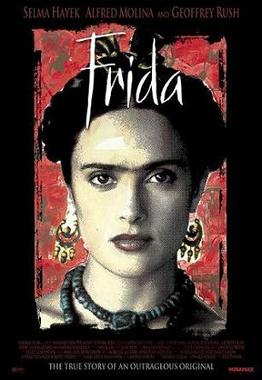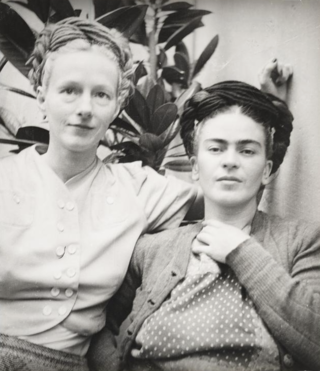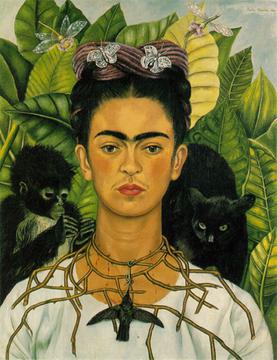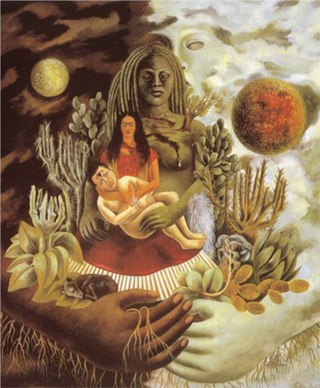
Diego María de la Concepción Juan Nepomuceno Estanislao de la Rivera y Barrientos Acosta y Rodríguez, known as Diego Rivera, was a prominent Mexican painter. His large frescoes helped establish the mural movement in Mexican and international art.

Magdalena Carmen Frida Kahlo y Calderón was a Mexican painter known for her many portraits, self-portraits, and works inspired by the nature and artifacts of Mexico. Inspired by the country's popular culture, she employed a naïve folk art style to explore questions of identity, postcolonialism, gender, class, and race in Mexican society. Her paintings often had strong autobiographical elements and mixed realism with fantasy. In addition to belonging to the post-revolutionary Mexicayotl movement, which sought to define a Mexican identity, Kahlo has been described as a surrealist or magical realist. She is also known for painting about her experience of chronic pain.

Frida is a 2002 American biographical drama film directed by Julie Taymor which depicts the professional and private life of the surrealist Mexican artist Frida Kahlo.

Tina Modotti was an Italian American photographer, model, actor, and revolutionary political activist for the Comintern. She left her native Italy in 1913 and emigrated to the United States, where she settled in San Francisco with her father and sister. In San Francisco, Modotti worked as a seamstress, model, and theater performer and, later, moved to Los Angeles where she worked in film. She later became a photographer and essayist. In 1922 she moved to Mexico, where she became an active member of the Mexican Communist Party.

Dorothy Hale was an American socialite and aspiring actress who died by jumping off a building in New York City. Her husband's death, followed by several unsuccessful relationships, had left her financially dependent on her wealthy friends. The artist Frida Kahlo created a famous painting commissioned by Clare Boothe Luce, titled The Suicide of Dorothy Hale.

Diego et Frida is a biography of Mexican painters Diego Rivera and Frida Kahlo by French Nobel laureate J. M. G. Le Clézio. It was originally published in the French language in 1993.

The Frida Kahlo Museum, also known as the Blue House for the structure's cobalt-blue walls, is a historic house museum and art museum dedicated to the life and work of Mexican artist Frida Kahlo. It is located in the Colonia del Carmen neighborhood of Coyoacán in Mexico City. The building was Kahlo's birthplace, the home where she grew up, lived with her husband Diego Rivera for a number of years, and where she later died in a room on the upper floor. In 1957, Diego Rivera donated the home and its contents to turn it into a museum in Frida's honor.

Emmy Lou Packard also known as Betty Lou Packard (1914–1998) was a Californian post-war artist known for painting, printmaking and murals.

The Two Fridas is an oil painting by Mexican artist Frida Kahlo. The painting was the first large-scale work done by Kahlo and is considered one of her most notable paintings. It is a double self-portrait, depicting two versions of Kahlo seated together. One is wearing a white European-style Victorian dress while the other is wearing a traditional Tehuana dress. The painting is housed at the Museo de Arte Moderno in Mexico City.

Self-Portrait with Thorn Necklace and Hummingbird is a 1940 self-portrait by Mexican painter Frida Kahlo which also includes a black cat, a gorila and two dragonflies. It was painted after Kahlo's divorce from Diego Rivera and the end of her affair with photographer Nickolas Muray.

The Wounded Deer is an oil painting by Mexican artist Frida Kahlo created in 1946. It is also known as The Little Deer. Through The Wounded Deer, Kahlo shares her enduring physical and emotional suffering with her audience, as she did throughout her creative oeuvre. This painting in particular was created towards the end of Kahlo's life, when her health was in decline. Kahlo combines pre-Columbian, Buddhist, and Christian symbols to express her wide spectrum of influences and beliefs.

The Love Embrace of the Universe, the Earth (Mexico), Myself, Diego, and Señor Xolotl is a 1949 painting by Frida Kahlo. Created in Mexico, the 70 cm x 60.5 cm painting was painted with oil on Masonite. It was featured on the reverse of the Series F $500 peso banknote, issued in 2010.
Cristina Kahlo y Calderón (1908–1964) was the sister of artist Frida Kahlo. Frida painted a portrait of Cristina, titled Portrait of Cristina, My Sister, and Diego Rivera, Frida's husband, also portrayed Cristina Kahlo in his work. Cristina, with whom Rivera had an affair, was painted by Rivera in the nude.

Two Nudes in a Forest is an oil painting by Mexican painter Frida Kahlo that was completed in 1939. It is also referred to as The Earth, Two Nudes in the Wood, or My Nurse and I. The painting was given to a close woman companion of Kahlo's, who some believe to be actress Dolores del Río. The two women in the painting also appear in Kahlo's 1938 painting What the Water Gave Me, and her spider monkey, which views the couple from the forest, also appears in Kahlo's 1937 Fulang-Chang and I.

Phyllis de Lappe, also known as Pele de Lappe or Pele deLappe (1916–2007) was an American artist, known for her social realist paintings, prints, and drawings. She also worked as a journalist, newspaper editor, illustrator, and political cartoonist. de Lappe had been a resident for many years in Berkeley, California and later, Petaluma, California.
Hayden Herrera is an American author and historian. Her book Frida: A Biography of Frida Kahlo was turned into a movie in 2002 and Herrera's biography Arshile Gorky: His Life and Work was named a finalist for the 2004 Pulitzer Prize for Biography or Autobiography.

Diego and I is a 1949 oil painting by the Mexican artist Frida Kahlo (1907-1954).
The Rivals is a 1931 oil-on-canvas painting by the Mexican artist Diego Rivera (1886–1957). It was commissioned by Abby Aldrich Rockefeller, the leading personage behind the inception of the Museum of Modern Art in New York City. Rivera created the work while on the ship SS Moro en route from Mexico to New York City. The picture portrays "Las Velas", a festival held in the Mexican state of Oaxaca, a fete in honor of local patron saints and of the abundance of spring.

Henry Ford Hospital is a 1932 oil-on-metal painting by the Mexican artist Frida Kahlo about her experience of delivering a dead male fetus on 4 July at Henry Ford Hospital in Detroit, Michigan, United States, when she was approximately 31⁄2 months pregnant. Depictions of childbirth, abortion, or miscarriage are rare in the canon of Western painting, and Kahlo is "one of the only major artists to directly communicate her reproductive grief through visual art." The "bloody and terrifying" painting opened a defining and influential era of Kahlo's career. The painting's first title was The Lost Desire. An alternate title is The Flying Bed.

Self-Portrait Dedicated to Leon Trotsky, also known as Between the Curtains, is a 1937 painting by Mexican artist Frida Kahlo, given to Leon Trotsky on his birthday and the 20th anniversary of the October Revolution. Kahlo and her husband, artist Diego Rivera, had convinced government officials to allow Trotsky and his second wife, Natalia Sedova, to live in exile in Mexico. The Russian couple moved into the Blue House (La Casa Azul), where they resided for two years.
















